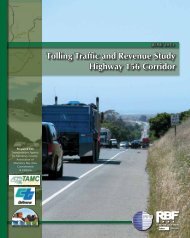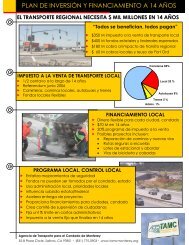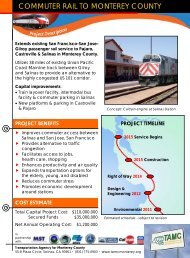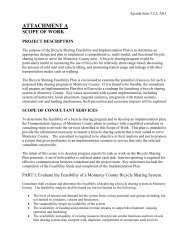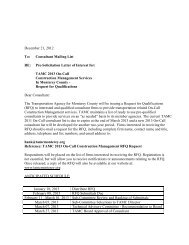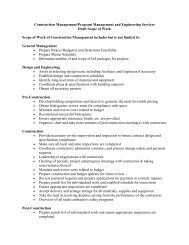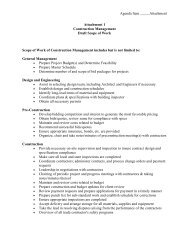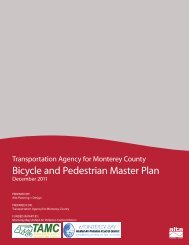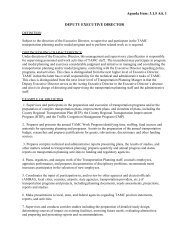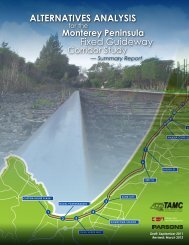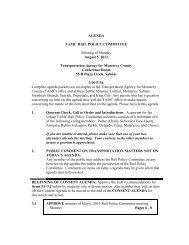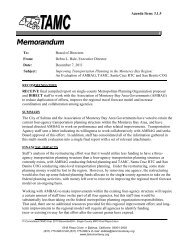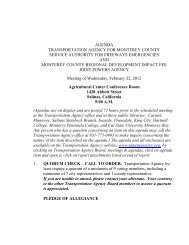Commuter Rail Extension Alternatives Analysis - Transportation ...
Commuter Rail Extension Alternatives Analysis - Transportation ...
Commuter Rail Extension Alternatives Analysis - Transportation ...
You also want an ePaper? Increase the reach of your titles
YUMPU automatically turns print PDFs into web optimized ePapers that Google loves.
CALTRAIN EXTENSION TO MONTEREY COUNTYALTERNATIVES ANALYSISMonterey County, Association of Monterey Bay Area Governments, MST, Caltrans, Santa CruzCounty Regional <strong>Transportation</strong> Commission, San Benito County, and the cities of Salinas andWatsonville has been meeting to discuss and plan the initial steps to creating this train serviceextension. This project is an outgrowth of their multi-agency coordination.Local and regional agencies representing the study area or portions thereof have conducted studiesthat serve as precursors or complements to this selection of a locally preferred alternative. Theproject has been coordinated with the Union Pacific <strong>Rail</strong>road, the Peninsula Corridor Joint PowersBoard, Caltrans, the Santa Clara Valley <strong>Transportation</strong> Authority, the City of Salinas, the RedevelopmentAgency of Monterey County, Monterey–Salinas Transit, the City of Watsonville, the Santa CruzCounty Regional <strong>Transportation</strong> Commission, and the Santa Cruz Metropolitan Transit District.In 1992, Passenger <strong>Rail</strong> Feasibility Study No. 05D423 was prepared for Caltrans to address the feasibilityof passenger rail service between San Francisco, Monterey, Salinas, and Hollister. The studyindicated that commuter rail could feasibly serve the existing market for work trips between Salinasand the Silicon Valley.A locally preferred alternative was adopted in the 1994 Monterey County Regional <strong>Transportation</strong>Plan. This included the extension of one Caltrain commute train. The 2002 and 2005 Regional <strong>Transportation</strong>Plans cite growing traffic congestion between Monterey County and the San Francisco BayArea and the demand for commuter rail services in the U.S. 101 Corridor. The 2005 Regional <strong>Transportation</strong>Plan includes the extension of Caltrain to Salinas in its list of planned projects.In 1997, the City of Watsonville prepared a Draft Pajaro Valley Station Project Study Report, in cooperationwith Monterey County, TAMC and the Santa Cruz County Regional <strong>Transportation</strong> Commission.While not finalized, this Draft project study report identified a potential site location and set ofprogram requirements for this station.Between 1998 and 2000, these program requirements and opportunities for adjacent site developmentwere further refined and explored by the Monterey County sponsored Pajaro <strong>Rail</strong>yards AreaFeasibility Study. This study, as well as the draft project study report, sited the Pajaro Valley stationadjacent to the former Southern Pacific Passenger Depot which is accessed from Salinas Road.In 2000, TAMC sponsored the preparation of the <strong>Extension</strong> of Caltrain <strong>Commuter</strong> Service toMonterey County Business Plan. The business plan considered, but did not thoroughly evaluate,alternative sites for stations at Pajaro and Castroville and a layover yard in Salinas.Caltrans’ <strong>Transportation</strong> Concept Report for U.S. 101 in Caltrans District 5 (2001) recommends thatdemand be reduced on U.S. 101 in Monterey and San Benito counties by encouraging and improvingalternative modes such as passenger rail, including the extension of Caltrain service from Gilroy toSalinas.With funding supplied by TAMC, Santa Clara Valley <strong>Transportation</strong> Authority, and others, UPRR hasundertaken a train simulation “capacity study” of potential freight and passenger rail operations innorthern California. Based on the results of this study, UPRR has identified track, switch, andsignaling improvements that may be required to implement additional passenger rail service toMonterey County. These have been documented by a "Term Sheet," dated June 26, 2003. Additionaltrack and signaling improvements have been identified in the California Passenger <strong>Rail</strong> System Five-Year Improvement Plan.parsons CHAPTER 8: EVALUATION OF ALTERNATIVES 214



